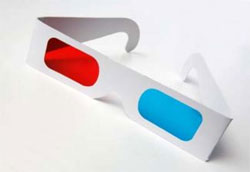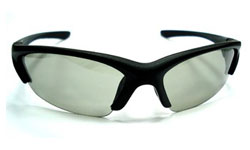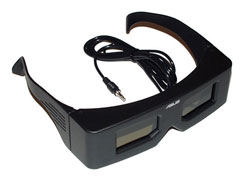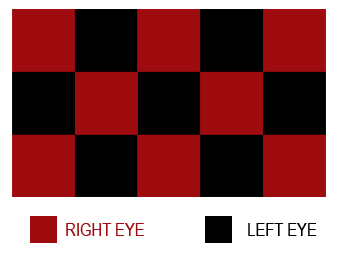3D TV Technology Guide for 2012 and Beyond
By Jack Burden

This is how you used to watch 3D TV
As good as the picture is on modern high definition televisions the image on the screen is still locked in two dimensions. Many manufacturers are starting to make or at least announce televisions that will bring your viewing experience into the 3rd dimension. Some of you may remember going down to the local 7-11 to pick up those paper glasses with the red and blue cellophane lenses to watch The Creature from the Black Lagoon in 3D on your old CRT set. The idea behind those paper 3D glasses is actually much older (the first 3D film was actually made in 1922) but the basic concept continues today. 3D TV works because we have 2 eyes and space between them. Our eyes see objects at a slightly different angle and our brain uses this information to reliably calculate distance or depth, especially with objects within 20 feet. 3D media uses this natural depth perception by sending a different image to each eye, our brains do the rest.
As recently as 2007 Consumer Electronics Show show, many new DLP based 3D TVs were introduced with a new Texas Instruments chip. These DLPs use shutter glasses, a transmitter to sync the glasses to the TV and 3D source material. I viewed many of these new introductions and was very impressed by the picture performance, but the recurrent drawback to these recent 3D TVs and as well as many in the past is that over time the eyes can become strained and cause headaches. Solving this issue is one of the big challenges facing the technology. If you start to get a headache while viewing 3D media, take a break and let your eyes rest.
At first 3D TV was almost entirely found on DLP televisions but as the technology caught on and as more content becomes available plasma, LCD and LED TV manufacturers have stepped into the 3D market. At CES 2010 nearly every manufacturer had a 3D enabled TV in their line up, most of them more than 1 line of 3D TVs.
What is 3D TV?
Projected 3D images work on a principle of sending a slightly different image to each of your eyes. With the old red and blue glasses the different images were projected in red and blue and the glasses filtered out one or the other to create the 3D effect. The 3D effect is fairly crude and the picture has to be monochrome since the entire effect is created by filtering colors.
Passive 3D

Modern 3D glasses look like sunglasses
Another method of producing a 3D image is using polarized lenses in the 3D glasses. This technique for producing a 3D effect is now termed Passive 3D. Two different polarized images are shown and each lens blocks out one of the images providing a full color 3D effect that is superior to the red and blue glasses. This is the method used in IMAX and other theaters showing 3D movies. Polarization works by using filters that only let waves of light through that are not aligned with filter. Each projected image is aligned with one of the lenses and the opposite lens lets that image through. This allows 3D display of a full color picture. The polarized 3D glasses look like any average pair of sunglasses you'd find on a store rack.
Active Shutter Glasses or Active 3D
A third method of creating a 3D image involves using shutter glasses - now called active shutter glasses. This method, often called "frame sequential display", has the user wearing powered glasses with an LCD screen that opens and closes like a camera lens. The 2 different images are shown in an alternating fashion while the glasses are synced via outboard hardware to open and close each lens separately providing one image to each eye. This effectively halves the frame rate of media being shown so a 60Hz LCD TV being used with shutter glasses will appear at 30Hz and 120Hz at 60Hz. Originally, with fast moving images this 3D technology suffered from flickering, but that issue has been resolved. As well, now active 3D panels produce true 1080p resolution to each eye - effectively doubling the resolution of passive 3D. However, the glasses are expensive and there is debate about how much better the picture depth is with active shutter glasses. They also must be recharged - usually by way of a convenient USB port in the TV or from a computer.
Another method of producing a 3D image is using polarized lenses in the 3D glasses. Two different polarized images are shown and each lens blocks out one of the images providing a full color 3D effect that is superior to the red and blue glasses. This is the method used in IMAX and other theaters showing 3D movies. Polarization works by using filters that only let waves of light through that are not aligned with filter. Each projected image is aligned with one of the lenses and the opposite lens lets that image through. This allows 3D display of a full color picture. The polarized 3D glasses look like any average pair of sunglasses you'd find on a store rack.
A third method of creating a 3D image involves using shutter glasses. This method, often called "frame sequential display", has the user wearing powered glasses with an LCD screen that opens and closes like a camera lens. The 2 different images are shown in an alternating fashion while the glasses are synced via outboard hardware to open and close each lens separately providing one image to each eye. This effectively halves the frame rate of media being shown so a 60Hz LCD TV being used with shutter glasses will appear at 30Hz and 120Hz at 60Hz. With fast moving images this 3D technology can suffering from flickering, also the tint of the glasses effectively lowers the screen brightness by up to 50%.

Older style powered shutter glasses
Shutter glasses are also used on the 3D capable DLP TVs available currently from Mitsubishi. Samsung's final line up of DLPs that were 3D capable also used this method but Samsung has since dropped it's DLP line. The DLP version of this technology uses a grid system that displays alternating squares like a checkerboard. Think of it showing the red and black squares in an alternating fashion with each lens synced to either the red or black squares to provide the 3D effect.

Future 3D TV Technology
Glasses are widely considered to be the weak link in the 3D chain. Consumers would much rather be able to view 3D without having to don any accessories. This is especially true of people who already wear corrective lenses and have to wear glasses over their glasses to view 3D TV.
The most advanced method of showing 3D uses a special screen that can direct separate images to each eye. This form of 3D technology is called "autostereoscopic" or lenticular and the picture is shown in columns which are alternately angled to the left or right eye using either a parallax filter or special lenses, this provides a 3D effect without the use of glasses but is currently only used on small monitors due to the strictly defined view distance limitations involved. If the viewer moves out of the sweet spot the 3D effect will fall apart or even invert. These screens and the media that utilizes them are still very rare. Larger versions of this technology are probably on the way but it suffers from two issues, price and the very limited view angle and distance.
Who is making 3D Televisions?
While it was originally limited to DLP televisions, 3D capability is becoming available on all the major HDTV technologies. At CES 2010 Panasonic introduced the VT25 series plasmas which offer full 1080p 3D to each eye and come equipped with everything needed to view 3D content. Sony, Samsung, Panasonic and others displayed both 3D capable traditional and LED backlit LCDs. Mitsubishi displayed 3D capable DLP televisions at their own booths.
In our discussions with the manufacturers at CES we were informed that 3D capability is not a feature that will add to the cost of the TV. Currently the announced TV's with 3D capability are almost all top line models though so it may be a few TV generations before it is a common feature on more affordable televisions.
What 3D Content is Available?
Currently there are almost 100 3D movie titles as of the end of the year 2011. ESPN also has lots of programming coming out regularly in 3D including the BCS championship football game, the Masters, and about 10 other large sporting events. The 3D network for ESPN was launched in June 2010. DirecTV also has some 3D programming channels. Some 3D TVs have 2 dimensional to 3 dimensional conversion, but it has never been something we have recommended due to quality issues.
Whether or not the 3D programming was filmed in 3D or not is a key to the quality of the content. Conversion techniques for turning original 2D content into 3D titles is never as good as if the original filming was done with 3D cameras.
For more on 3D TV visit 3D TV Buying Guide: 3D TV Reviews, Models, Articles and Buying Tips




